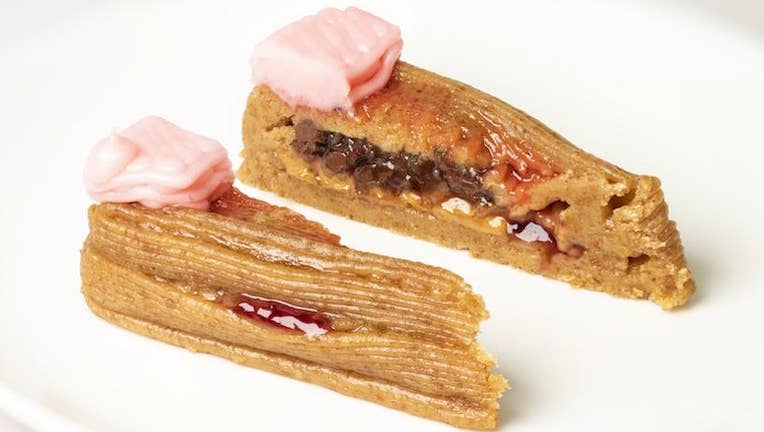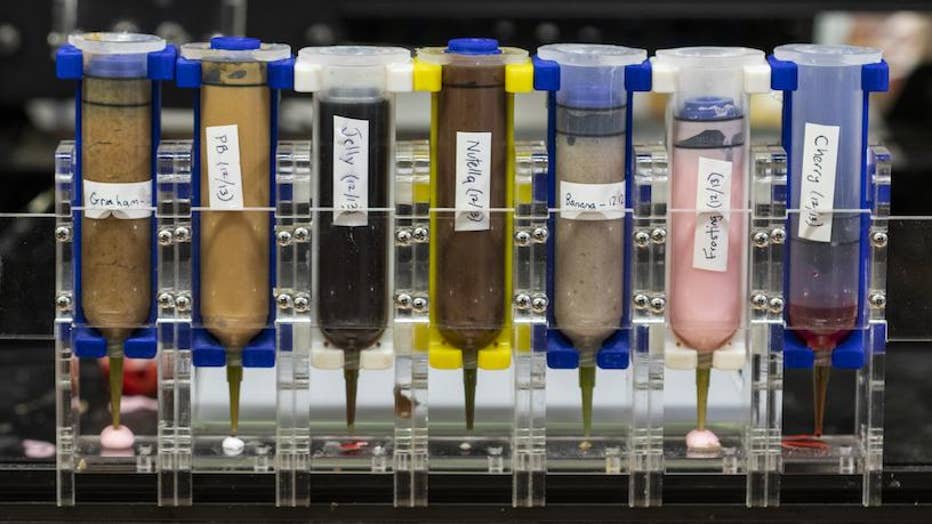Future of food? Researchers create 3D-printed cheesecake

The 3D-printed cheesecake using edible food inks, including peanut butter, Nutella, and strawberry jam is pictured. Credit: Provided / Jonathan Blutinger/Columbia Engineering
NEW YORK - 3D printing technology has evolved in many ways over the years, resulting in transformative products like a 3D-printed ear made of living tissue, a new residential community of 3D-printed homes, and even the world’s first 3D-printed rocket.
But could this manufacturing technique ever become a mainstay in the kitchen?
Mechanical engineers at Columbia University are working to address this question by assessing the benefits of 3D-printed food, how it compares to the "normal" food we consume, and if such a software-driven process could ever be as beautifully designed as a high-end coffee maker on one’s kitchen counter.
The team of Columbia researchers created a 3D-printed cheesecake using edible food inks, including peanut butter, Nutella, and strawberry jam. The details were published on Tuesday in the journal NPJ Science of Food.
Traditionally, food printing technology has been limited to a few uncooked ingredients – leading to less than appetizing dishes, according to the researchers.
The team, led by Dr. Jonathan Blutinger with Columbia’s Creative Machines Lab, aimed to push the limits of food printing by using many different ingredients that were cooked using a laser.
To do this, they created a seven-ingredient cheesecake: graham cracker, peanut butter, Nutella, banana purée, strawberry jam, cherry drizzle, and frosting.

The 3D-printing system that constructs a dish comprising seven ingredients, cooked in situ using a laser. Credit: Provided / Jonathan Blutinger/Columbia Engineering
Several different designs were tested, and the team found that the most successful one used graham cracker as the foundational ingredient for each layer of the cake. They said that peanut butter and Nutella proved to be best used as supporting layers that formed "pools" to hold the softer ingredients of banana and jam.
The Columbia researchers pointed out some health benefits to such a technology.
"We have an enormous problem with the low-nutrient value of processed foods," co-author and Professor Christen Cooper with Pace University Nutrition and Dietetics said in a statement. "3D food printing will still turn out processed foods, but perhaps the silver lining will be, for some people, better control and tailoring of nutrition--personalized nutrition."
Cooper added that food printing could also be useful in making food more appealing to those with swallowing disorders by mimicking the shapes of real foods with the pureed texture foods such patients require.
What’s the potential of 3D food printing?
In the study, several barriers to widely adopting 3D-printed food were noted, including the need to store food inks at certain temperatures and the cost. Although such machines can be built small to conveniently fit in a kitchen, the price may affect consumers’ early adoption.
It also needs a larger industry to support it.
"Because 3D food printing is still a nascent technology, it needs an ecosystem of supporting industries such as food cartridge manufacturers, downloadable recipe files, and an environment in which to create and share these recipes," Blutinger said in a statement.
"Its customizability makes it particularly practical for the plant-based meat market, where texture and flavor need to be carefully formulated to mimic real meats," he added.

3D 'Alt-Steak' printed using plant-based 'fat, blood and muscle'
Redefine Meat, a food 3D printing company that produces animal-free meat, has announced its first 3D printed plant-based product ? the ?Alt-Steak.?
The team said people with dietary restrictions, parents of young children, nursing home dieticians, and athletes could all find the personalized techniques of 3D food printing useful and convenient in meal planning.
For chefs, such techniques could help localize flavors and textures on a millimeter scale.
Additionally, food prepared "with less human handling" could lower the risk of foodborne illness and disease transmission in the post-pandemic era.
"This seems like a win-win concept for all of us," Blutinger said.
This story was reported from Cincinnati.

